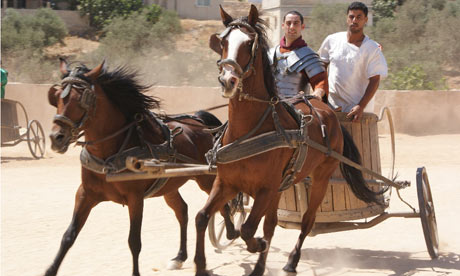
Seconds before I cause a fatal chariot-and-Roman legionary pile-up involving horrendous and senseless loss of innocent life, scenes of a happy childhood flash before my eyes.
Kitted out in the full dress and armour of a soldier of the VI Legion – branded the Ironsides by Julius Caesar – I'm driving a light racing chariot around the 2,000-year-old hippodrome in Jerash, northern Jordan, at what might turn out to be literally breakneck speed. And I am not the only one worried. The 40 actors playing Roman legionaries who are standing in my direct path look more than a little concerned.
Chariots sped around this track from the first to the seventh centuries AD. Then an earthquake caused a brief hiatus until 2005 when Stellan Lind, a Swedish fan of Ben Hur, opened the Roman Army Chariot Experience, which demonstrates the sport and lets you have a go.
I have come here in the hope that I will develop a talent for it and thus secure a job in the chariot-filled Ben Hur Live show that kicks off a multi-million-pound tour at London's O2 Arena on Thursday. Fifteen years in the making, the producers of Ben Hur Live claim it could be "the most successful show ever". No less than 46 horses are used in the production and the music has been specially composed by Stewart Copeland of the Police, who also narrates (necessary because the actual dialogue is in Latin and Aramaic). The show requires 400 cast and crew, not to mention 500 tons of sand, which together will be trucked to 15 cities across Europe over the next year.
All very well but the show in Jerash, Jordan, has one crucial advantage – the audience is allowed to take part. This happens at the end of the show, when spectators are invited to get up and try racing each other.
As my race begins, I shout encouragement at the horses, whip the reins and learn how to command two animals at once. They are spirited, fire-snorting creatures who frequently rear up and attack either each other or the horses drawing the other chariots. The 35C heat beats down and sweat runs off my brow as I battle to keep the horses under control, dragging them back into the race when they become preoccupied with their own rivalries. The danger points are the two ends of the track – hippodromes are not circular, but have two parallel "straights" with hairpin bends at each end.
As you turn the corner, your inside wheel often lifts clear of the ground and if your horses are a touch too lively, your chariot can flip over. You keep your balance by bending your knees, since both your hands are on the reins and there is no way to hold on.
This all goes on amid the triumphal arches, majestic theatres and half-fallen columns of the Roman city. It is as dramatic a backdrop as you could hope for. In ancient times, the hippodrome seated 15,000 baying spectators, although a crowd of a few hundred is the norm nowadays. The crowd ranged on the stone seats today cheer as I approach at speed, but the (actors dressed as) legionnaires are standing dangerously close to where my horses seem to be running. A ripple of interest, rapidly turning into concern, and then fear passes through the massed soldiers and they begin to break ranks, then chaotically abandon their formation to run for their lives.
The audience loves it. They think it is a clever comedy stunt. But out of the corner of my eye, I see our centurion drop his shield and spit on the ground. Spitting is rarely a sign of good humour. The only thing preventing this trip ending up as a minor news item is that this is the final lap and my horses come to a stop beside those of the two other chariots, who have both beaten me and avoided civilian casualties in so doing.
Having narrowly side-stepped tragedy, we salute the crowd, who cheer once more. Then at the compere's signal – did the Romans have comperes? – we leap triumphantly from the vehicles. As I walk out of the arena I pass the centurion. He looks at me and scowls before spitting again.
• Ben Hur Live has its world premiere at the O2 on Thursday and runs until Sunday before touring Europe. For details of the show, see benhurlive.com.
• Tickets for the chariot races in Jerash, including the chance to try chariot driving, cost £10 adults, £2 children (jerashchariots.com). Flights to Amman with Royal Jordanian Airlines cost from £360 (rj.com). Cox and Kings has a seven-night Splendours of Jordan tour, including Jerash, from £1,225 (coxandkings.co.uk). Voyages Jules Verne's seven-night Discover Jordan tour, including Jerash, starts from £795 (vjv.com).

